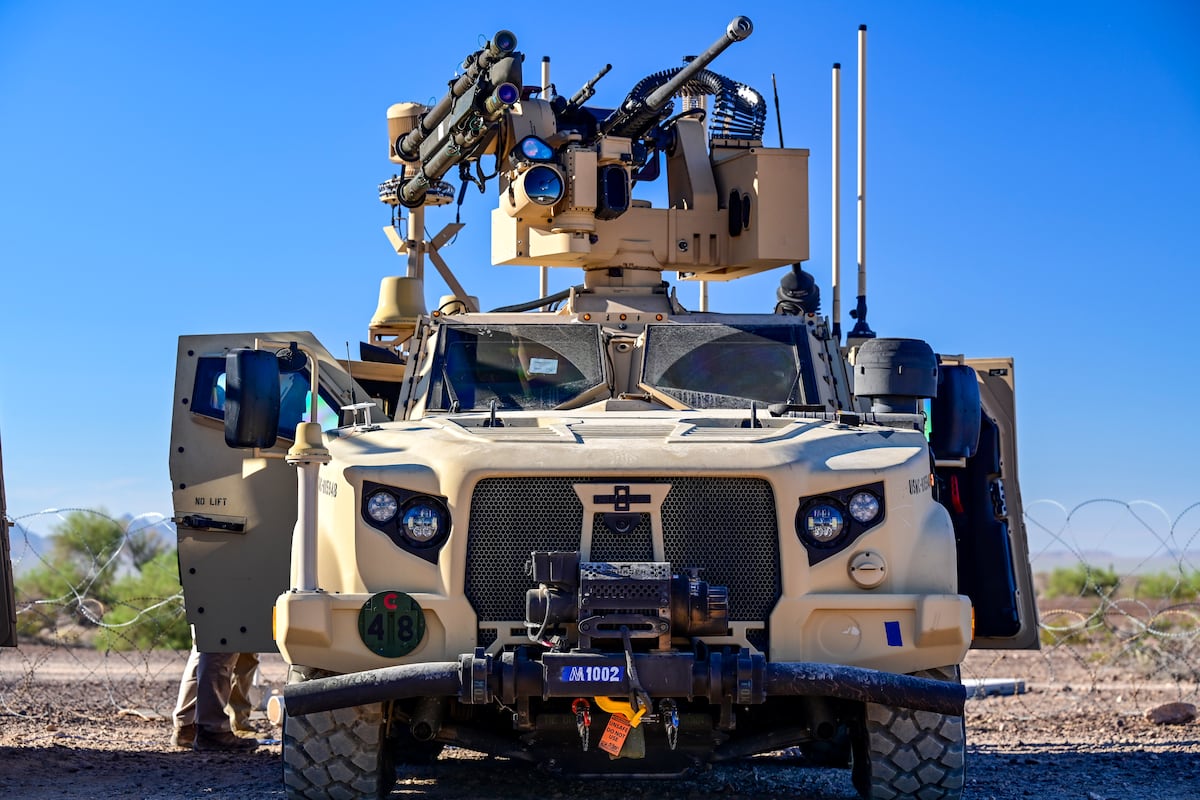One of the Marine Corps’ newest operational formations recently fielded a crucial “workhorse” air defense system to counter enemy drones and other aerial threats.
Leathernecks with the 3rd Littoral Anti-Air Battalion, 3rd Marine Littoral Regiment in Hawaii received the Marine Air Defense Integrated System, or MADIS, as the newly formed unit positions itself to counter threats in the Indo-Pacific region, according to a Marine Corps Systems Command release.
“The rapid rise of UAS, used for surveillance, targeting and attacks, has made advanced air defense systems like MADIS critical to protecting our Marines and preserving our combat effectiveness,” said Lt. Col. Craig Warner, Future Weapons Systems product manager. “MADIS not only detects, tracks and defeats aerial threats but also serves as a powerful deterrent, signaling to adversaries that their aerial assets will not succeed against U.S. forces.”
All services continue to face a growing drone threat in every area of operations. In 2018, the Marines responded by beginning to build capacity for a “layered defense,” one that would eventually use the MADIS, Col. Andrew Konicki told Marine Corps Times. Konicki manages the Corps’ Ground-Based Air Defense program office.
Marine officials have called the MADIS, built by Kongsberg Protech Systems USA, the “basic building block of the LAAD battalions’ ground base air defense capability.”
RELATED
For non-air defenders, MADIS allows Marines to focus on their mission instead of the sky, giving Marines one major threat they no longer have to worry about.
“MADIS creates its own [anti-access, area-denial] bubble,” Warner said.
The system replaces a cumbersome legacy platform Marines have long used to defend the skies. The Man-Portable Air Defense System, or MANPADs, includes a fire unit vehicle, section leader vehicle and the Stinger shoulder-fired missile as its primary weapon system, according to the Marine Corps.
Some version of that platform has been in place since the Army and Marine Corps first developed anti-aircraft protection measures against fast-moving aircraft in the 1950s.
MADIS, meanwhile, removes the need for a Marine to ever exit their vehicle, manually sight in and destroy an enemy aircraft.
The Joint Light Tactical Vehicle-mounted MADIS allows users to track and detect both friendly and enemy aircraft and select kinetic options, such as missiles or gunfire, and non-kinetic options, such as signal jammers or lasers, before disabling the threat.
The MADIS, which uses two JLTVs, includes multiple systems, such as radar, surface-to-air missiles and command and control elements. Each vehicle complements the other.
“In layman’s terms, one detects, and the other attacks,” according to a Marine release.
The new unit fielding the MADIS, the Hawaii-based 3rd MLR, is the Corps’ first operational littoral regiment. The service seeks to establish two additional regiments in the Pacific, with the 12th MLR slated for Okinawa, Japan, and the 4th MLR planned for Guam.
The new regiments are a slimmed down version — about 1,800 to 2,000 Marines — of the traditional infantry regiment, with missiles instead of conventional artillery, their own landing craft, anti-air battalions and other features purpose-designed for littoral combat. A conventional Marine infantry regiment can contain up to 2,200 Marines.
A light version of the MADIS, aptly named the L-MADIS, saw its operational debut in July 2019, when Marines aboard the amphibious assault ship Boxer used the system, mounted on a Polaris MRZR all-terrain vehicle, to shoot down an Iranian drone, Marine Corps Times previously reported.

The light version is “uniquely aligned” to the Marine Expeditionary Units, smaller than an MLR with a broader range of missions. The MADIS can handle the air defense needs of larger formations and can synchronize and coordinate with the L-MADIS, Konicki said.
The Corps’ Fiscal Year 2024 budget request included $130 million for 13 MADIS Increment 1 systems.
In 2022, the Marines held an industry day to develop capabilities for the next version of MADIS to defeat larger drones.
“Fielding MADIS to [3rd] LAAB is only the first step,” Konicki said. “What MADIS is today will not be the same system 12, 24, 36 months from now.
Through 2035, the Corps is planning to field a total of 190 MADIS systems to the 1st, 2nd and 3rd Low Altitude Air Defense battalions — which are separate from the Littoral Anti-Air Battalions — and the 3rd, 4th and 12th MLRs.
Beyond continued upgrades to software, power consumption and capabilities for the system, Marine officials released a request from industry for proposals on a smaller, dismounted version of the MADIS capability earlier this year, Konicki added.
System fielding by the LAAD battalion will begin in the fourth quarter of fiscal 2025, according to the release.
Todd South has written about crime, courts, government and the military for multiple publications since 2004 and was named a 2014 Pulitzer finalist for a co-written project on witness intimidation. Todd is a Marine veteran of the Iraq War.
Read the full article here





